Amid constant adjustments to social media algorithms and search engine rankings, it can feel near impossible to get your content noticed. While organic search is the free and perhaps more comfortable option, the chances of going viral without putting some money on the table are slim.
Although earned and owned media hold their own marketing value, paid social advertising is the surest way to bring in traffic and sales from day one. As of 2021, 75% of Gen Zers and 48% of millennials are making purchasing decisions influenced by social media ads, and in 2020, social media ad spend in the US was valued at $40.3 billion.
Whether you’re a big or small business owner, social media advertising is a must, especially if you want to stand out from the crowd, gain content views and drive more sales.
What is Social Media Advertising?
Social media advertising, or social media targeting, are advertisements served to users on social media platforms.
Social networks utilize user information to serve highly relevant advertisements based on interactions within a specific platform. In many instances, when the target market aligns with the user demographics of a social platform, social advertising can provide huge increases in conversions and sales with lower cost of acquisition.
In this blog post, we’ll cover all the ins and outs of social media advertising, from managing a campaign to different types of ads, as well as practical examples of how to put them into practice.
How to Manage Your Social Media Advertising Campaign
1. Run your ad campaigns manually.
Out of the three ways to manage a campaign, running it manually is going to be your cheapest option — and the simplest. All you have to do is choose an advertising platform and set up your campaign.
Pros
Running an ad campaign manually gives you the freedom to invest 100% of your budget into testing out ads and finding the best ones, rather than spending extra money on ad management tools or agency fees.
Plus, taking charge of your own campaigns will inevitably allow you to develop an eye for advertising so that you can learn and improve your campaigns in the future. Instead of letting someone else do the work, you can become an expert yourself and be able to speak the language, even if you do end up hiring outside advertisers down the road.
Cons
Of course, becoming an advertising expert takes time and commitment, which means that the more time you invest in advertising is lost time in other areas of your business. Especially if you are a business owner, spending hours on end mastering advertising might not be conducive to a busy work schedule.
And just because you invest a lot of time in becoming an advertising expert does not mean that your ads will be successful. Especially if you’re just stepping into the advertising world, it may be a gamble to invest all that time and risk not getting the results you want.
Who it’s ideal for
If you’re operating on a tight budget and simply don’t have the means to hire an advertising agency, running your campaigns manually is your best bet — but unless you’re already a seasoned advertiser, you need to be willing to put in the time and effort to learn.
However, if you don’t have the money or the time, there is a second option that might be more suitable.
2. Run your ad campaigns via automated software.
Considering social media ad spending is expected to reach $153,974 million in 2021, it’s no wonder there’s a plethora of third-party tools to help you manage your campaigns.
Pros
Sometimes on-site ad managers aren’t the most user-friendly, but third-party tools like AdEspresso or Revealbot can make optimizing Facebook ad campaigns and analyzing results much simpler than using Facebook’s Ad Manager.
Or, you can even use automated tools like Adext, which uses AI to manage the entire campaign. This way you can focus on other areas of your business while the platform does the rest.
With so many tools on the market, you’ll be able to save time, optimize campaigns and ensure that their money is going toward ads that will actually turn into sales.
Cons
Although third-party tools are often relatively affordable, they are still an additional cost to consider.
And just like manually running your own ad campaign, automated software still poses the risk of spending the money but not getting the results you want. Plus, since you aren’t controlling the entire campaign process, it might be more difficult to identify where the ads manager is falling short.
Who it’s ideal for
For merchants who are working on a tight budget but also don’t have the time to invest in running their own campaigns, using third-party tools is the happy medium.
Creating a successful campaign is definitely achievable with automated software and minimal invested time, and for business owners with limited resources, this is likely the best option. However, for those who have the budget and want the best ad campaign possible, the easiest option is to turn to the professionals.
3. Hire a managed service to run your ad campaigns.
While this last option is often the most expensive, it’s also the simplest and will likely reap the most benefits. Rather than relying on your own expertise or automated software, hiring a professional is the most reliable option for achieving the results you want.
Pros
Of course, the most obvious advantage of hiring an advertising professional is that they know what they’re doing — it’s their job. As a result, the chances of you getting your desired results are much higher.
Plus, hiring a managed service means there’s zero work on your part, so you can invest time and energy into other areas of your business that need more focus.
So, although you’d be paying a fee and ad spend, the hope is that your advertising will turn into consistent sales and keep you net positive.
Cons
The one downside to hiring an ad agency is that if you don’t hire a good ad agency, you could end up wasting a lot of money.
Unfortunately, some agencies are only self-proclaimed experts who lure customers into wasting their money, so make sure you do your research and only hire trustworthy professionals.
Who it’s ideal for
For those who have the budget to spend and are eager for immediate sales, hiring a managed service is the most ideal solution. And since social media advertising is easily measurable, if your ads aren’t performing up to your standards, then you know exactly who is responsible, and you can always hire a new and better agency.
5 Steps to Build a Creative Social Media Advertising Strategy
1. Determine what to sell.
If your ecommerce business only produces and sells one product, or if you already have an obvious bestseller, you can skip this step.
However, if your business has a larger product catalog, you’ll need to identify which of your products are most valuable and therefore should be central to your advertising efforts.
Below is a helpful diagram that can help you calculate your gross profit per SKU to determine which of your products hold the highest value.
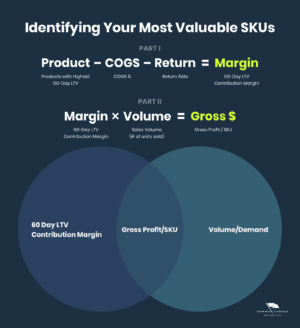

Once you calculate each of your products’ value, you can determine which ones are generating high profits but are underrepresented in the ad account and adjust accordingly. While you can create a good advertisement for an average-selling product, featuring a bestselling product will likely result in more conversions and sales.
2. Research your audience.
Ultimately, the customer is not just purchasing the physical product itself, but more importantly, what the product can do for them. In fact, Common Thread Collective identifies three levels of product problems:
- Physical: The product itself.
- Functional: What the product does for the customer.
- Identity: How the product makes the customer feel.
Therefore, before trying to sell to your audience, you first have to understand who they are and what they want. But knowing the functional purpose of your product and what your customers actually want isn’t always black and white.
Here are a few tips to help answer these questions.
First, read reviews! Whether positive or negative, customer reviews are valuable insights to what your customers want and how they actually view your product. These reviews can come from your online store, blogs, YouTube videos or Reddit posts.
Take time to read through them — they’ll either provide reassurance that your business is on the right track, or they’ll give you insights about how to shift directions.
Second, utilize Google Trends and keyword searches to help understand how customers are thinking about different products and/or topics.
All you have to do is type in a word or phrase, and the “related queries” section will highlight which regions hold the highest search volume for that term, as well as related topics and queries, which open up avenues that could hold potential for your business.
Lastly, search for related hashtags on your brand’s social networks — this could be a great opportunity to find organic search for your products.
3. Use a creative platform.
While the genesis of social media has opened the door to so many new opportunities for digital advertising, you have to face the fact that all social platforms have their own limitations. Instagram, Snapchat, Facebook — all of them.
But that doesn’t mean you can’t still get creative within those limitations. There’s a world of possibilities for social media advertising, but, of course, social platforms are much different from television and magazines, so you’ll need to keep in mind a few limitations.
You have less time to grab the audience’s attention.
In a world of endless scrolling and short-form videos, it’s no wonder that Facebook users spend, on average, only 1.7 seconds with a piece of mobile content.
Therefore, marketers have less and less time to capture customers’ attention before they end up scrolling to the next thing. And the way to do this is by rejecting the traditional TV story arc — rising action, climax, falling action — and instead embracing an emerging story arc, which starts with the climax. By doing so, your ads can hook customers from the beginning and seamlessly lead them to a call-to-action.
Your product should be the star of the show.
While there is value in lifestyle product photography and ads, at the end of the day, the goal is to sell a product, so it should be your main focal point. Don’t focus too much on the models, the actors or all the fluff that goes into making ads — instead, focus on capturing the product itself and allowing it to shine on its own.
Create ads for mobile.
Considering over 98% of Facebook users access the app via a mobile device, it’s vital that your ads aren’t only made to fit a 16-by-9 TV or desktop screen — they need to be adjusted for mobile use, too.
Not only should your ads physically fit on a mobile screen, but they also need to be designed with the mobile user in mind. This means legible branding, large and clear text, eye-catching graphics and interactivity whenever possible.
4. Create a digital marketing campaign.
Now that you know your product, audience and platform, it’s time to start putting the pieces into action.
Not sure where to start? Here are four steps to get you on your way to building a successful digital marketing campaign.
Define your goals.
Although it might be an obvious first step, setting clear and reachable goals is a vital foundation for creating a successful campaign. It can be easy to jump into a campaign with lots of vision and ambition, but if you don’t have a focused approach, these ambitions may fall short. Whether it’s brand awareness, more social media followers or a higher SEO ranking, make sure you have a definable goal in mind that can guide you in your decisions throughout the process.
Identify your target audience.
Although we already touched on this, it’s worth saying again: know your audience! The more you understand who your customers are and what they want, the better you’ll be able to refine your advertising to better meet their needs.
Create customer personas.
This goes along with the previous step, but here is where you’ll go a bit more in depth. A customer persona is a detailed description of your target customer, which highlights their demographics such as age, location, occupation, income and other details that may influence the way they make purchase decisions.
Determine your budget.
While this might not be the most fun part, assessing your budget is key to determining what your limitations are and how you should be allocating your resources. Luckily, social media marketing is generally less expensive than traditional marketing, so your investments in digital will often give you more bang for your buck.
5. Improve your performance.
Return on advertising spend (ROAS) can clue you in to whether your ads are working, but they can’t tell you why if they aren’t.
In the end, the goal of social media advertising is to drive traffic and gain more sales. But before a customer hits the “Complete Purchase” button, there are several steps they have to move through to get there — and as a marketer, it’s your job to make sure they do.
To help understand how customers experience advertisements and content, you can use the AIDA system, which stands for attention, interest, desire and action.
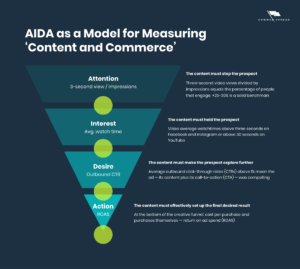

Designed in 1898 by ad executive E. St. Elmo Lewis, AIDA is a behavioral model that highlights the four effects an ad should produce in a customer. Below is a great visual that details each of these effects and what they look like in practice.
Types of Social Media Marketing
Gone are the days of billboards and magazines being the only advertising mediums. As the world of content and digital marketing grows, there is a buffet of advertising options to choose from, each holding its own unique strengths and limitations. Here we’ll highlight some of the most common types of ads and how they can add value to your campaign.
1. Photo ads.
Likely the most familiar type of ad, you’ll often see photo ads strewn across news feeds, sidebars and banners. They’re a bit simpler to create than other ads like videos and stories, but you’ll need to make sure that your photos are high-quality. For instance, Sprout Social recommends 1080×1080 pixels for Instagram image and carousel ads.
Photo ads are great for building brand awareness, since they place your product right in front of the customer. Just make sure that your images are consistent in style with your posts and stories so that users immediately associate the ad with your brand.
And of course, photo ads are effective in bringing traffic to your website. In fact, a Facebook study found that a series of photo-only ads outperformed other ad formats in bringing unique traffic.
Unlike organic posts, photo ads may include a call-to-action button like “Shop Now” or “Download,” which helps create a seamless purchase experience for the customer.
2. Video ads.
According to Vidyard, over half of all social media users will watch a full video if it is under one minute long, and the longer the video is, the smaller this percentage becomes.
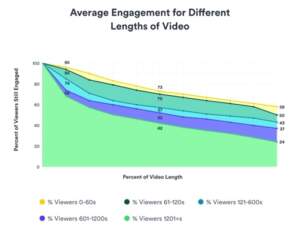

This means that you only have a short length of time to reel in a user and keep them hooked. Luckily, platforms like Instagram and Facebook allow you to create short, looping video ads that users can quickly view and interact with while scrolling through their feed.
However, if you have a compelling message and the resources to do so, you can also opt for longer video content, like this video from Cordova Outdoors.
3. Stories ads.
According to a study by Instagram Business, half of the users surveyed said they visited a website to purchase a product or service as a result of viewing it on a Stories ad. And considering Instagram has 1 billion active users, this is a huge opportunity for you to make your brand known.
If you’re advertising on Facebook Stories, a photo can be viewed for six seconds, while a video can play for up to 15 seconds. On the other hand, Instagram Stories ads can be up to 120 seconds long, whether you’re using photos or videos. On both platforms, Stories ads display in full-screen format, allowing your product to be in full focus as long as you have your customer’s attention.
4. Messenger ads.
No, social media ads don’t have to only appear in a user’s news feed! Facebook Messenger ads, unlike photo, video and Story ads, are displayed between conversations in a user’s Chats tab in Messenger. Potential customers can click on the ad to begin an automated conversation through Messenger, or the ad can link them to your website to browse products.
Social Media Platforms Examples
When deciding where to place your ads, keep in mind that each social media site holds its own unique audience — so find out where your ideal customers are and meet them there. If your target audience is in the age range of 60 and up, a social platform like TikTok probably isn’t your best option, but perhaps Facebook is.
And if your brand is already active on social media, find out which platforms are already performing well organically — this might be a good indicator of where you should be targeting your advertising efforts.
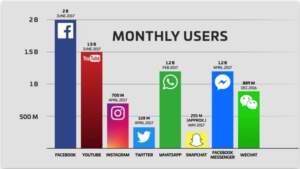

1. Facebook.
As the largest social media platform in the world, it’s safe to say that Facebook is a reliable choice when deciding where to advertise. Facebook is popular among a wide variety of demographics, including gender and age (shown in a report below by Hootsuite), which means there’s a good chance your target audience is engaging with the platform, too.
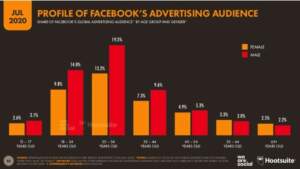

Aside from allowing Facebook users to connect with one another and share content online, the platform also offers merchants the opportunity to advertise their products and services online. Among a laundry list of benefits, these are a few ways that Facebook ads can help you meet campaign goals:
- Build brand awareness: Increase your reach and get your products in front of potential customers.
- Consideration: Direct traffic to your website, harness lead generation through opt-in emails, blog posts and content and reach out to potential customers through Messenger.
- Conversion: Set up a Facebook Shop to give customers a more seamless shopping experience, drive traffic to both your online and brick-and-mortar stores and increase conversion rates.
Plus, Facebook advertising allows merchants to target customers by location (within a 5-mile radius), occupation, interests, past activity and several other valuable data points.
Pricing for Facebook ads varies depending on several factors, including the audience you’re trying to target and the budget you set for your ads. However, as a rule of thumb, the more ad spend, the more efficient Facebook’s algorithm becomes at spending your money and increasing your ad performance over time.
2. Instagram.
Known for its glossy photos and videos, Instagram is an ideal platform for brands with products that are visually appealing and easily incorporated into visual media.
Plus, with an engagement rate 58% higher than Facebook’s and 2,000% higher than Twitter’s in 2016, Instagram holds a massive user base, although one that’s largely younger than other advertising platforms.
So, if your business and target audience fits both of those characteristics, Instagram advertising might be the best option for you.
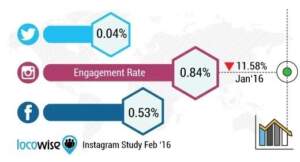

Although organic posts and stories can be great ways to boost traffic to your website, Instagram ads can be directly linked to your product page or another landing page, allowing for quick and easy engagement with your products.
3. Twitter.
As the go-to platform for discovering breaking news and engaging with small- and big-name influencers, Twitter has been one of the most popular social media channels since its launch in 2006.
Twitter advertising offers two options for brands to create ads:
- Quick Promote: Twitter automatically promotes Tweets to your target audience. All you have to do is choose a promotable Tweet from your timeline and specify your target audience, and Twitter will do the rest of the work for you.
- Twitter Ads: These ads are objective-based, meaning you first have to choose your preferred business objective, and Twitter will only bill you for actions that align with your goal.
4. Tiktok.
Although a relatively newer player in the social advertising game, TikTok holds huge potential for reaching potential customers, especially younger audiences.
According to eMarketer, many of TikTok’s social commerce capabilities have primarily focused on product ads which appear as native videos on users’ “For You” feeds. The ads are full-screen and appear for nine seconds, just like an organic TikTok post. Under each advertisement, users can tap the “Shop Now” button, which brings them directly to the merchant’s ecommerce site to complete their checkout.
Besides in-feed ads, other ad options on TikTok include Brand Takeovers, which means that your ad will be displayed as soon as a user opens the app, or a Branded Hashtag Challenge, which encourages user-generated content through trending hashtags and fun video challenges, like a popular dance or creative filter.
5. Pinterest.
Like Instagram, Pinterest is a highly visual platform, decorated with whimsical wedding photos, cooking videos and fashion reels. But with that being said, Pinterest is largely geared toward women with a 71% female user base.
Considering Pinterest users intentionally use the platform to find and purchase products, Pinterest is one of the most ideal platforms for social media advertising. Promoted pins easily blend into the Pinterest boards without distracting users like some other platforms do. In fact, 85% of weekly Pinners have made a purchase based on Pins they see from brands.
Especially beneficial for ecommerce retailers, Pinterest has a highly targeted search engine which allows brands to advertise their products by promoting their highest-performing pins.
6. Linkedin.
As the world’s largest professional network, LinkedIn holds a large professional user base and is able to target customers based on job qualifications. Thus, LinkedIn advertising is largely geared toward a corporate audience.
Considering 69% of LinkedIn US users earn $50,000 or more per year, this platform tends to hold the highest average disposable income and high-quality leads in certain industries.
However, unlike most other platforms, which focus on B2C advertising, the nature of LinkedIn makes it better suited to B2B advertising campaigns. So, service businesses and B2B product businesses tend to get better results on LinkedIn than other platforms.
There are four types of LinkedIn ads:
-
Sponsored content: These ads — often through photos, videos or carousels — are displayed in LinkedIn’s newsfeed in order to reach a larger audience.
-
Sponsored Messaging: This is LinkedIn’s version of email marketing, but rather than sending a message to the user’s inbox, it goes to their LinkedIn inbox, where the user can then interact either with a chatbot or a human customer representative.
-
Text and Dynamic ads: Only visible to desktop users, text ads are small advertisements displayed at the top of the screen above the user’s newsfeed.
-
Lead Gen forms: Using pre-filled forms in your LinkedIn ads, you can collect quality leads at scale.
Social Media Advertising Examples
After you’ve determined your social platform and the types of ads you want to display, it’s time to put your advertising wheels in motion. To help get you started, here are five social media hacks to get more eyes on your content and start turning viewers into customers.
1. Audience targeting.
Targeting an audience means to zone in on a select demographic, whether it be age, gender, occupation or interest — but you can’t target everyone using the same tactic.
Using keyword search, surveying and interviewing customers and creating clear customer personas, you’ll get a better picture of who your customer is, and therefore you’ll be able to target them more accurately.
Not only should you be targeting new and potential customers, but also make sure to retarget existing customers. This will help remind customers of your brand even if they’ve already made a purchase, and it’s much more cost-effective than advertising to potential customers.
2. Promote on social media platforms.
This may go without saying, but a key aspect of social media advertising is upping your social media strategy. Promoting and repurposing your organic content across social media channels will help you to tell your brand story and make it stand out.
3. Paid search and social ads.
Using remarketing lists for search ads (RLSA), you can tailor your PPC search ads based on whether a customer has previously visited your online store as well as which pages they viewed. This way you can target users who are already familiar with your business.
However, you can take this up a notch by combining paid search with social ads to target both those who know and don’t know your brand.
By first targeting with social ads, you can build brand awareness and help customers become more familiar with your products. Then, when they see your PPC ads later on, they’ll feel more comfortable and inclined to click on your website.
4. Improve quality score.
Quality score is a ranking metric that search engines use to indicate the quality of your keywords and PPC ads, and therefore it’s a key aspect of social media advertising. The higher your quality score, the higher your ad will rank and the more impressions it will get at a lower cost per engagement.
By posting organically to social advertising platforms and tracking engagement with each ad, you’ll be able to pinpoint which paid ads are top-performing — these are the ones you want to promote.
5. Optimize user engagement for SEO.
One of the key ways to bring traffic to your website and consequently drive sales is by optimizing your ad content. Among other ranking factors like keywords, page speed and mobile friendliness, one potential SEO factor is user engagement. These metrics include click-through rate (CTR), bounce rate and conversion rate, among others.
However, even if user engagement isn’t a core ranking factor for search engines, high CTRs and conversion rate will still achieve better organic search rankings and more conversions.
Wrapping Up
Especially in the ecommerce landscape, social media advertising is one of the most efficient and effective ways to reach your target audience and turn them into customers. No other advertising avenue can deliver the same consistent, scalable leads as social advertising.
As more and more retailers dip their toes into social media, it’s crucial that you understand the ins and out of this advertising medium and start strengthening your own strategy. But with these tips under your belt and actionable goals to guide you through the process, you’ll be way ahead of the curve.






